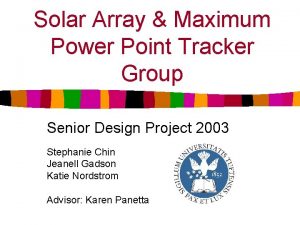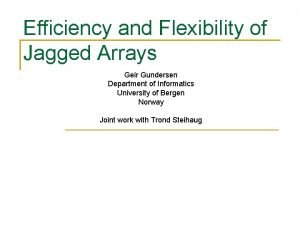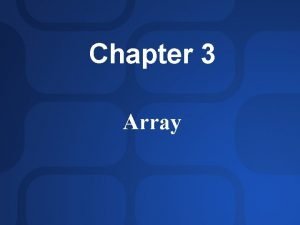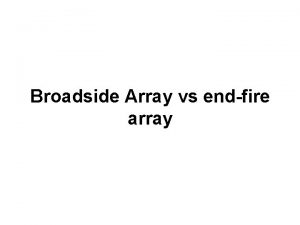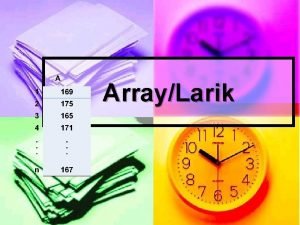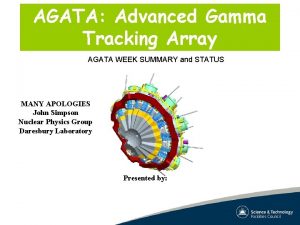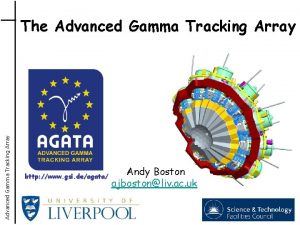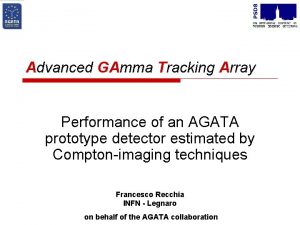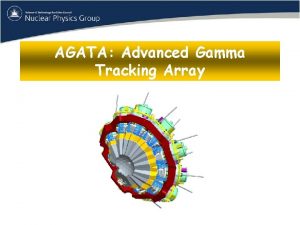The AGATA project Advanced GAmma Tracking Array for







- Slides: 7

The AGATA project Advanced GAmma Tracking Array for g - ray spectroscopy under extreme conditions in a very large energy range with high efficiency and very good spectral respons concept of - ray tracking design and development Joint Resaearch Activity (EURONS) Witek Męczyński The Henryk Niewodniczański Institute of Nuclear Physics Polish Academy of Sciences, Kraków, Poland North-East European Network meeting, September 14– 15, Kraków

Concept of - ray tracking EUROBALL limited det. efficiency; poor en. resolution at high recoil velocity W ~ 0. 4 MODEL too many detectors are needed to avoid summing effects W ~ 0. 8 AGATA W ~ 0. 8 segmented detectors; interaction points of all -rays are determined; full energy of every -ray is reconstructed

Design and development 36 -fold segmented Ge detector Triple cluster module hexagonal tapered shape max. diam. 80 mm, length 100 mm encapsulated in Aluminium can Position sensitivity obtained by Pulse Shape Analysis of the real signal from a segment and induced signals in its neighbours. Position determination in 3 D: < 5 mm Tracking Algorithms use the results of PSA for reconstruction of the individual g-rays 1 - 3 encapsulated det. in a common cryostat 2 - preamps 3 - frame support 4 - digital pulse procesing electronics 5 - fibre-optic channel for data transfer 6 - LN 2 dewar 7 - target

AGATA 4 p - array Array: 180 hexagonal crystals in 60 single clusters 12 pentagonal crystals individually canned 6 780 segments! 230 kg of high purity germanium inner(outer) radius: 17(26) cm solid angle coverage: 77 % Major improvements in: Efficiency (Eg=1 Me. V): 50% (Mg=1) 25% (Mg=30) Angular resolution: 1 o FWHM (1 Me. V, v/c=50%): ~ 5 ke. V ! Rates: 3 MHz (Mg=1), 0. 3 MHz (Mg=30) Sensitivity: 107 Construction: ~ 8 years, completed in 2007/9 Cost ~40 M€, Effort ~150 MY

Joint Research Activity: objectives of the project demonstration of the new technology with a small AGATA sub-array: set of tracking modules with digital pulse-processing electronics, data acquisition system and ancillary detectors for performance evaluation objectives of the project and the EU contribution: development, construction, commissioning and evaluation of the prototype AGATA module and associated electronics starting date: January 1, 2005, duration: 4 years

Joint Research Activity: management of the project 41 institutions and laboratories from 11 European countries Memorandum of Understanding: to develop, fund, construct and operate an AGATA demonstratrion array to form a research network to investigate novel aspects of nucl. structure Organisation of the AGATA project: AGATA Steering Committee AGATA Manegement Board AGATA Working Groups Poland Detector Module Local Level Processing Global Level Processing Design&Infrastructure Ancillary Detectors Data Analysis EU Contact

Joint Research Activity: Polish contribution to the project Institutions: Heavy Ion Laboratory, Warsaw University Institute of Experimental Physics, Warsaw University The Andrzej Sołtan Institute for Nuclear Studies, Świerk The H. Niewodniczański Institute of Nuclear Physics Polish Academy of Sciences, Kraków Working groups: Global Level Processing Data Analysis Ancillary Detectors Research team: 8 persons Contributed effort: 6 men-years
